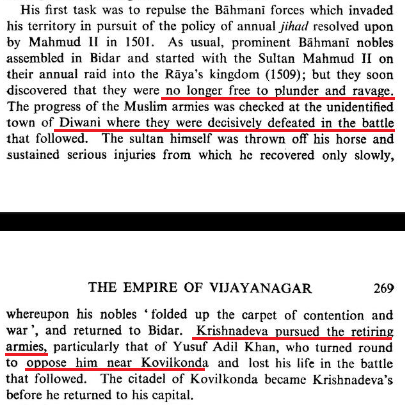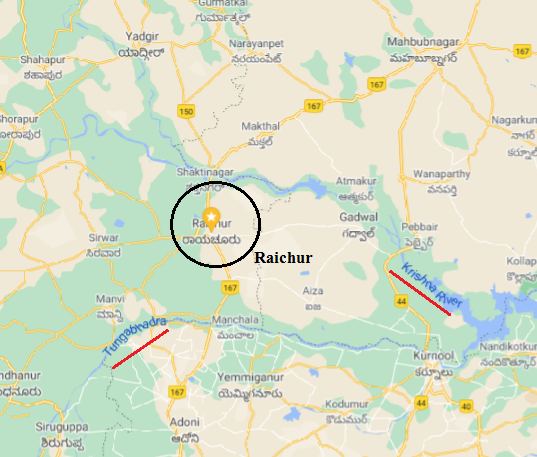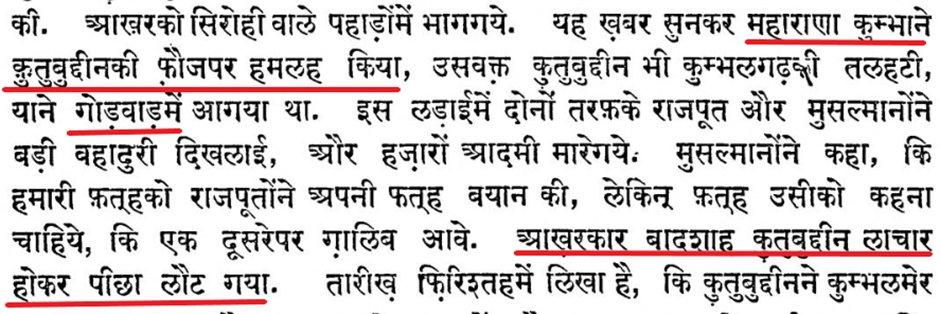1.
#Thread on Maharajadhiraja Krishna Deva Raya of the mighty Vijayanagara Empire.
One of the most enlightened & powerful Hindu rulers of Bharatvarsha, his reign will be described in this 2-part-thread-series.
This is the 1st part.
#VijayanagaraEmpire #Hindutva #History
#Thread on Maharajadhiraja Krishna Deva Raya of the mighty Vijayanagara Empire.
One of the most enlightened & powerful Hindu rulers of Bharatvarsha, his reign will be described in this 2-part-thread-series.
This is the 1st part.
#VijayanagaraEmpire #Hindutva #History

2.
1509, Aug 17: Krishna Deva Raya was coronated on the occasion of Krishna Janmashtami. He signalised it by building the Eastern Tower of Sri Virupaksha Temple.
At the time of coronation, Vijayanagara's political condition was not stable. Two aggressive Muslim Sultanates ...


1509, Aug 17: Krishna Deva Raya was coronated on the occasion of Krishna Janmashtami. He signalised it by building the Eastern Tower of Sri Virupaksha Temple.
At the time of coronation, Vijayanagara's political condition was not stable. Two aggressive Muslim Sultanates ...



3.
... had cropped up at the empire's northern frontier - Adilshahi (Bijapur) & Qutbshahi (Golconda). In addition, the Portuguese had landed in India ~11 yrs earlier in 1498.
1509: Mahmood Shah II, the Bahmani Sultan, had started a practice of 'annual j1had' in 1501.

... had cropped up at the empire's northern frontier - Adilshahi (Bijapur) & Qutbshahi (Golconda). In addition, the Portuguese had landed in India ~11 yrs earlier in 1498.
1509: Mahmood Shah II, the Bahmani Sultan, had started a practice of 'annual j1had' in 1501.


4.
In 1509 however, they were defeated in Battles of Diwani, and Kovilkonda. Yusuf Adilshah was k1lled at Kovilkonda.
This has been described poetically in Amuktamalyada, a work attributed to Krishna Deva Raya himself! 👇

In 1509 however, they were defeated in Battles of Diwani, and Kovilkonda. Yusuf Adilshah was k1lled at Kovilkonda.
This has been described poetically in Amuktamalyada, a work attributed to Krishna Deva Raya himself! 👇


5.
1510: After Adilshah lost Goa to Portuguese, Hindus of Belgaum revolted against Adilshah & called themselves subjects of Vijayanagar - the Hindu Empire (according to Ugargol inscription)
1510: After Adilshah lost Goa to Portuguese, Hindus of Belgaum revolted against Adilshah & called themselves subjects of Vijayanagar - the Hindu Empire (according to Ugargol inscription)

6.
1512: Adilshahi was going through a succession crisis/coup. Krishna Deva Raya marched for Bijapur (Vijayapura). Unable to fight the Raya, Adilshah surrendered Mudgal, Addanki, Adoni & Raichur forts to Vijayanagar 👇
1512: Adilshahi was going through a succession crisis/coup. Krishna Deva Raya marched for Bijapur (Vijayapura). Unable to fight the Raya, Adilshah surrendered Mudgal, Addanki, Adoni & Raichur forts to Vijayanagar 👇

7.
In the same year, Qutbshah had committed excesses on Hindus of Rachakonda & Devarakonda.
The Raya invaded Qutbshah with *600k-strong-army*! The other Shahs buried mutual enmity & joined Qutbshah to fight the Hindu Emperor. At the banks of Krishna however, they were defeated.
In the same year, Qutbshah had committed excesses on Hindus of Rachakonda & Devarakonda.
The Raya invaded Qutbshah with *600k-strong-army*! The other Shahs buried mutual enmity & joined Qutbshah to fight the Hindu Emperor. At the banks of Krishna however, they were defeated.

8.
1514: The Raya invaded the unstable Adilshahi. In the Battle of Jamkhandi, Sadasiva Naika, the Vijayanagar general, defeated combined armies of Adil-,Nizam-, & Imadshahi. Gulbarga was taken & Bahmani Sultan Mahmood Shah II was reinstated by Raya.
*Yavana-Rajya-Sthapanacharya*

1514: The Raya invaded the unstable Adilshahi. In the Battle of Jamkhandi, Sadasiva Naika, the Vijayanagar general, defeated combined armies of Adil-,Nizam-, & Imadshahi. Gulbarga was taken & Bahmani Sultan Mahmood Shah II was reinstated by Raya.
*Yavana-Rajya-Sthapanacharya*


9.
1516: Vijayanagar attacked Qutbshah & conquered Telangana. Sadasiva Naika again defeated Bahmanis at Bidar in a hard-fought battle. While proceeding to Odisha from Bidar, another Muslim general, Shitab Khan was defeated.
After march till Cuttack, Gajapatis sued Raya for peace
1516: Vijayanagar attacked Qutbshah & conquered Telangana. Sadasiva Naika again defeated Bahmanis at Bidar in a hard-fought battle. While proceeding to Odisha from Bidar, another Muslim general, Shitab Khan was defeated.
After march till Cuttack, Gajapatis sued Raya for peace

10.
According to the peace treaty, Vijayanagar returned the territory north of Krishna to Odisha, & daughter of Prataprudradeva was married to Krishnadevaraya.
1518: Vijayanagar general, Saluva Timmaiah, defeated Qutbshahi general Madar-ul-Mulk while en route to Kondavidu.
According to the peace treaty, Vijayanagar returned the territory north of Krishna to Odisha, & daughter of Prataprudradeva was married to Krishnadevaraya.
1518: Vijayanagar general, Saluva Timmaiah, defeated Qutbshahi general Madar-ul-Mulk while en route to Kondavidu.

11.
1520: Sometime after 1512, Ismail Adilshah had conquered Raichur Fort.
The Raya sieged Raichur with *~750k* army total. Adilshah set out to relieve the siege of Raichur, but the Vijayanagar army was in the way, at the northern side of the Fort.
1520: Sometime after 1512, Ismail Adilshah had conquered Raichur Fort.
The Raya sieged Raichur with *~750k* army total. Adilshah set out to relieve the siege of Raichur, but the Vijayanagar army was in the way, at the northern side of the Fort.
12.
Battle of Raichur on 20 May 1520, in which Adilshah was *decisively defeated* due to superior cavalry tactics of Vijayanagar army. The Adilshah dreaded Vijayanagar for his whole life!

Battle of Raichur on 20 May 1520, in which Adilshah was *decisively defeated* due to superior cavalry tactics of Vijayanagar army. The Adilshah dreaded Vijayanagar for his whole life!
https://twitter.com/GaikwadAnkur/status/1357386336471244803


13.
After this decisive victory, the Sultanates warned the Raya against harsh treaty, threatening to unitedly fight him.
To this, the haughty Raya replied that *no territory will be returned*, & if Sultanates desired a united war, he'd be happy to give them a fight! 🔥
After this decisive victory, the Sultanates warned the Raya against harsh treaty, threatening to unitedly fight him.
To this, the haughty Raya replied that *no territory will be returned*, & if Sultanates desired a united war, he'd be happy to give them a fight! 🔥

14.
In the next part of the series, we will look at the later part of the reign of Krishnadevaraya, his eulogies, as well as the *glory* Vijayanagara Empire attained due to his enlightened rule.
#Hindutva #VijayanagaraEmpire #History
In the next part of the series, we will look at the later part of the reign of Krishnadevaraya, his eulogies, as well as the *glory* Vijayanagara Empire attained due to his enlightened rule.
#Hindutva #VijayanagaraEmpire #History
https://twitter.com/HindutvaItihas/status/1399750853846831104
• • •
Missing some Tweet in this thread? You can try to
force a refresh























